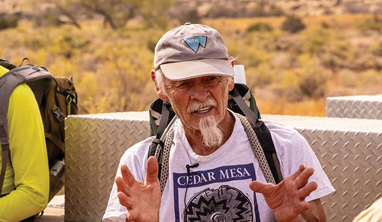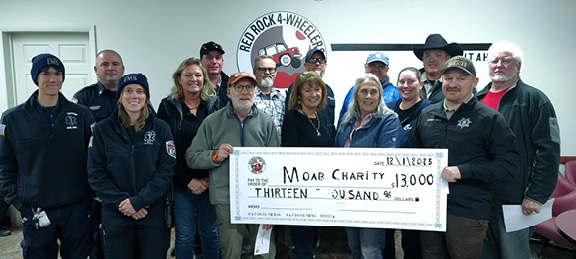Some information may be outdated.
Residents with water rights on the south end of Moab are being asked by the state to “defend and protect” their claims.
A summons being sent to residents by the Utah Division of Water Rights that says all rights to the use of water, (both surface and underground) are now being determined in the drainage area of the Colorado River in Grand County.
“[It] shall be your duty to follow further proceedings in the above entitled action and to defend and protect your water rights therein,” the summons explains.
The summons is part of the legal process for the state’s program to record historical and current water use in the Moab valley. This adjudication process is defined by hydrogeologic boundaries and includes the Mill Creek and Pack Creek watersheds.
Utah Division of Water Rights Southeastern Regional Engineer Marc Stilson said people using water for irrigation and domestic culinary water uses should be aware that the state has begun the adjudication process for the south end of Moab. There are about 600 water rights claimed in this area Stilson said, which encompasses south of Spanish Trail Drive to the end of the valley in San Juan County.
“When we review a water right, we look at all the uses,” Stilson said.
Stilson estimated about 90% of the field work on determining water rights for users in the northern part of Moab is now finished. The final field work for the southern area is expected to be completed by the end of this year.
“By mid-summer 2020 we’re hoping to have the whole valley done,” Stilson said.
Those residents who receive a summons will be given directions for how to proceed in the water rights adjudication process. Utah Division of Water Rights (DWRi) held an open house on April 25 at the Grand Center and delivered a presentation to explain the water adjudication process and answer questions from the public.
The Moab Sun News wrote about the state’s water adjudication program in the northern part of Moab in September and reported that 142 unclaimed water rights in that area could be abandoned. Stilson said the news report prompted about 20 people to contact the division, lowering the number of unclaimed water rights from 142 to 120.
In the northern area, which had about 580 claimed water rights, Stilson said about 70 claims submitted were nonexistent. For example, water rights that were attached to wells that have been buried or filled in.
“Even though there was a claim submitted, there was nothing to check,” Stilson said.
He said another example would be a well on a property that is no longer being used because the home has been connected to city municipal water.
Stilson said he has seen instances in which new wells have been drilled, but no new water rights were filed.
Stilson said the DWRi is helping people in situations where new wells were drilled on their property, but the owners didn’t follow through with the paperwork, or they need to update their claims because their water use from the wells has changed over the years.
The division can assist people with filing new paperwork who have claims but no record of it, Stilson said. He said there were about 50 wells in the southern adjudication area that had been drilled but had no attached water rights.
In one example, he said a person had originally filed a water claim for 0.1-acre but over the years they had expanded their water use as they developed their lot. Existing water rights can be modified, but not expanded, Stilson said. This could mean that some people retain their original water right and file a new water right claim for their expanded uses.
Most of the water rights in the Moab area are for homes and domestic uses, Stilson said. Those who file for new water rights in building and development have about 5 years to do the development and show the state proof, documented by an engineer or surveyor, that the water right has been put into use.
“There’s hasn’t been a lot of agricultural waters rights lost,” Stilson said.
But some water uses have been lost through time. Stilson gave an example of an old gas plant that has a well on its property. The well is there, Stilson said, but the water rights are no longer recognized and the use is gone because the water has not been used for several years.
“In Utah, if you don’t use your water for a period of 7 years or more, it’s potentially subject to forfeiture,” Stilson said.
The forfeitures happen by court order through the general adjudication process. Cities are exempt from the 7-year rule, so it doesn’t apply to water rights owned by the City of Moab that are not yet developed for use.
If you receive a summons and you think you have a water right, Stilson said you should file a water claim. Residents who do not respond to the summons or fail to file their water use claims are at risk of losing their water rights through abandonment.
Stilson and other DWRi employees are visiting Moab area residences to inspect the water rights claims.
“We tell them why we’re here, and they show us around, show us how they use their water,” Stilson said. “Almost universally, the people we’ve met have been great to work with.”
Stilson and his team are based in Price, but he said someone from the division is in the Moab area every week to work on the adjudication program.
The determination of these historical and existing water rights in the Moab valley will be used to determine how much water is being used from the groundwater aquifers in the valley and will be included in developing the Groundwater Management Plan for Moab and Spanish Valley.
The DWRi’s 2018 press release about developing the Groundwater Management Plan says that “on paper, the water resources in (the) Moab valley are over-appropriated.”
“Almost universally, the people we’ve met have been great to work with.”
Moab area residents summoned to cooperate with water rights adjudication
Appreciate the coverage? Help keep local news alive.
Chip in to support the Moab Sun News.




